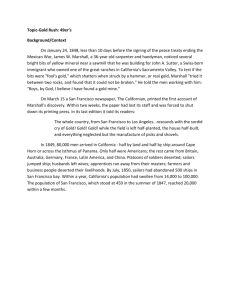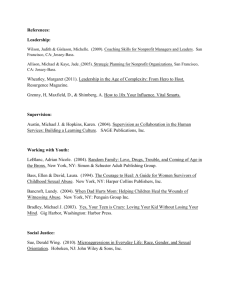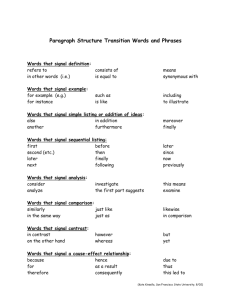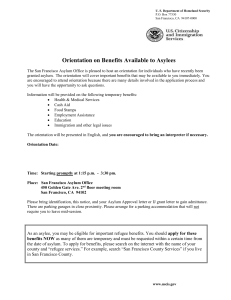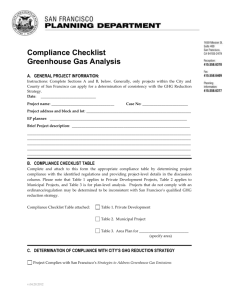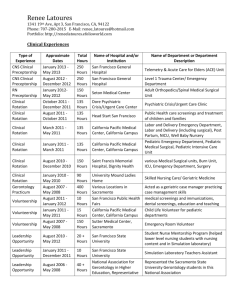HISTORY 1 - City College of San Francisco
advertisement
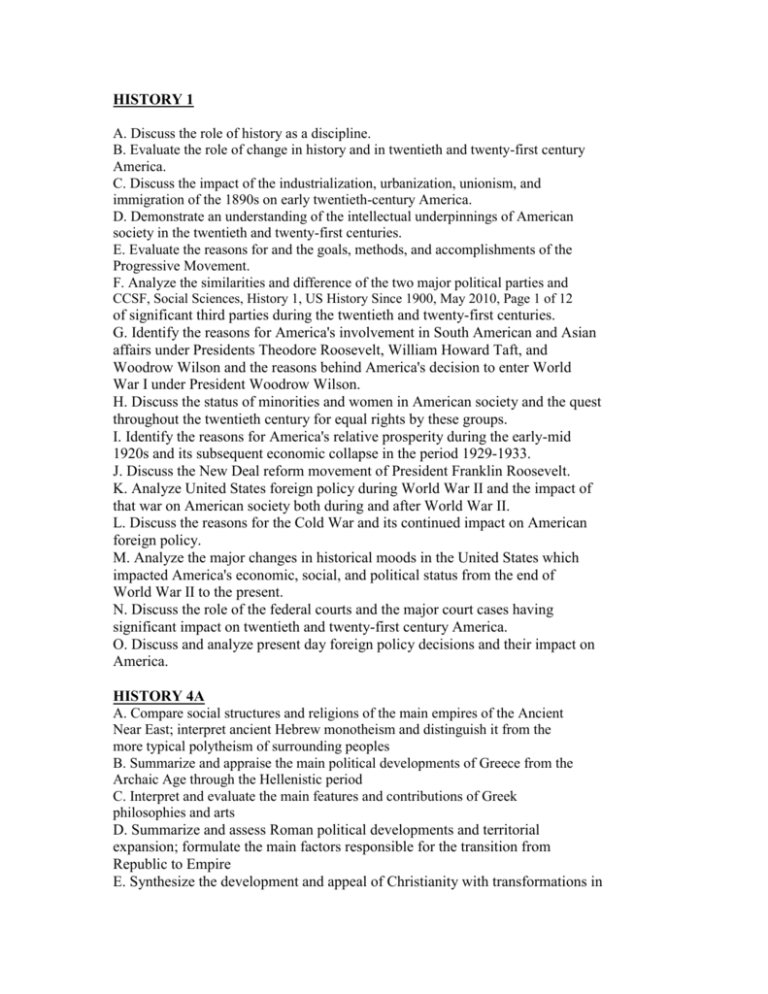
HISTORY 1 A. Discuss the role of history as a discipline. B. Evaluate the role of change in history and in twentieth and twenty-first century America. C. Discuss the impact of the industrialization, urbanization, unionism, and immigration of the 1890s on early twentieth-century America. D. Demonstrate an understanding of the intellectual underpinnings of American society in the twentieth and twenty-first centuries. E. Evaluate the reasons for and the goals, methods, and accomplishments of the Progressive Movement. F. Analyze the similarities and difference of the two major political parties and CCSF, Social Sciences, History 1, US History Since 1900, May 2010, Page 1 of 12 of significant third parties during the twentieth and twenty-first centuries. G. Identify the reasons for America's involvement in South American and Asian affairs under Presidents Theodore Roosevelt, William Howard Taft, and Woodrow Wilson and the reasons behind America's decision to enter World War I under President Woodrow Wilson. H. Discuss the status of minorities and women in American society and the quest throughout the twentieth century for equal rights by these groups. I. Identify the reasons for America's relative prosperity during the early-mid 1920s and its subsequent economic collapse in the period 1929-1933. J. Discuss the New Deal reform movement of President Franklin Roosevelt. K. Analyze United States foreign policy during World War II and the impact of that war on American society both during and after World War II. L. Discuss the reasons for the Cold War and its continued impact on American foreign policy. M. Analyze the major changes in historical moods in the United States which impacted America's economic, social, and political status from the end of World War II to the present. N. Discuss the role of the federal courts and the major court cases having significant impact on twentieth and twenty-first century America. O. Discuss and analyze present day foreign policy decisions and their impact on America. HISTORY 4A A. Compare social structures and religions of the main empires of the Ancient Near East; interpret ancient Hebrew monotheism and distinguish it from the more typical polytheism of surrounding peoples B. Summarize and appraise the main political developments of Greece from the Archaic Age through the Hellenistic period C. Interpret and evaluate the main features and contributions of Greek philosophies and arts D. Summarize and assess Roman political developments and territorial expansion; formulate the main factors responsible for the transition from Republic to Empire E. Synthesize the development and appeal of Christianity with transformations in the Roman Empire during the Third and Fourth Centuries A.D. F. Interpret the main features of Christian and Muslim doctrine and organization as these religions evolved from their founding periods through the Middle Ages G. Compare the development of Germanic Kingdoms in Western Europe with the Byzantine Empire and the Islamic world during the early Middle Ages H. Examine and evaluate transformations and continuities in the culture, politics, economy, and religion of Western and Central Europe during the High Middle Ages; analyze the relationship between monarchs and popes, and between commercial developments and the growth of towns and cities I. Consider and appraise the medieval crusades from the points of view of Europeans, Byzantines, and Muslims J. Summarize and interpret the main features of medieval philosophy and artistic expressions K. Consider and evaluate the economic, political, religious, and demographic changes and crises of the late Middle Ages L. Analyze leading Renaissance humanists and artists and relate their work to political and economic developments of the period M. Formulate the main causes of the Protestant Reformation; contrast Martin Luther's views with those of the Roman Catholic Church and distinguish between Luther, John Calvin, and other Protestants N. Appraise the successes and limitations of the Protestant and Catholic Reformations and their effects on European society and politics; assess the causes and outcomes of the Thirty Years' War HISTORY 4B A. Discuss and understand the historical processes that have forged the evolution of Western Civilization to the present. B. Demonstrate an understanding of the rise of royal absolutism and constitutionalism in 17th • Century Europe. Co Explain the cultural and scientific innovations of the seventeenth century. D. Discuss the economic expansion of Western Civilization via the Atlantic system of commerce and capital in the seventeenth and eighteenth centuries. E. Discern the power structures and alliance systems of 18th • Century Europe. F. Explain the origin, course and aftermath and significance of the Enlightenment and French Revolution. G. Discuss the emergence of the Industrial Revolution in Western Europe in the late eighteenth and early nineteenth century. H. Explain the Political evolution of the nineteenth century west from the establishment of a Conservative Order after Napoleon's tenure of power to the triumph of Liberalism by the late nineteenth century in much of Europe. I. Discuss the evolution of the United States as an offshoot of Western Civilization in the late 18th • And early 19th• Century and its maturity into a major western nation by the late nineteenth century. J. Explain the origin and impact of 19th • Century ideologies. H. Critically examine the course of 19th • Century European Culture. I. Explain the evolution of the modem Nation-States in Europe by the latter third of the nineteenth century. J. Analyze the Origins o the Great War. K. Discuss the course, outcome and aftermath of the First World War. L. Examine the political, economic, social and cultural dynamics of the 1920's. M. Examine the political, economic, social and cultural dynamics of the 1930's. N. Analyze the causes of the Second World War. O. Explore the course, outcome and impact of World War II. P. Explain the rise of the Cold War, the end of European Empire and Decolonization. Q. Discern the recovery and reconstruction of western Europe after WWII. R. Explain the course of Soviet Communism and the sovietization of eastern Europe After WWII. S. Discuss the emergence of the United States as the new center of Western Civilization after WWII and the course of its political, social and economic modernization. T. Discern the post-modem west of the 1960's, 1970's and 1980's. U. Explain the end of the Cold War, the reuinification of Germany, the end of the Soviet Union, European Union and the challenges and opportunities for the West in the new Millennium. HISTORY 5 A. Discuss and understand the historical processes that have forged the European experience since 1900. B. Demonstrate a comprehension of the peoples and states of fin-de-siecle Europe up to the eve of 1914. C. Explain the origins of the Great War, its progression and its impact upon European society. D. Discuss the revolutions and restorations of 1917 - 1921 (Bolshevism, the Versailles Treaty). E. Discern the developments in European culture and thought during the "Twenties". F. Explain the impact of the Great Depression on Europe during the 1930's. CCSF, Social Sciences, History 5, Europe Since 1900, May 2010, Page 10f3 G. Discuss the rise of totalitarianism and its consequences (Communism, Fascism, National Socialism). H. Explain the origins of the Second World War, 1939 - 1945, its progression, impact upon Europe and the resulting new world order. I. Discuss the European States and the Cold War. J. Explain the economic recovery o western Europe from 1948 to 1963. K. Analyze the impact of Soviet Communism on European life. L. Critically demonstrate an understanding of western Europe in the 1960's and 1970's. M. Explain the volatile and dramatic decade of the 1980's. N. Explain the decade of the 1990's. O. Discuss the efforts of present day Europeans to forge intra-European unity amongst nation-states whose histories' weigh heavily upon them. HISTORY 12A A. Identify, discuss, and evaluate the key intellectual, cultural, social, economic, and political factors that comprise the experiences, roles, and contributions of women to United States history from the pre-colonial period through the 1880s. B. Discuss, explain, and analyze the key similarities and differences in women's experiences, roles, and contributions across racial, ethnic, and class lines from the pre-colonial period through the I880s. C. Analyze historical topics and the causes and consequences of events dealing with the arrival of Native Americans, colonization, the American Revolution, the Great Awakening, early industrialization, democratic reform movements in the antebellum Era, the Civil War and Its Aftermath, Women in the West, organized womanhood and The women's rights movement through the 1880s. D. Identify, discuss, and analyze how women dissolved the tension between the restrictions placed upon them as women and efforts to elevate women's position and achieve equality. E. Identify, discuss, and analyze women's experiences, roles, and contributions during the antebellum era of reform. F. Identify, discuss, and analyze the women's rights movement through the 1880s. HISTORY 12B A. Identify, discuss, and evaluate the key intellectual, cultural, social, economic, and political factors that comprise the experiences, roles, and contributions of women to United States history from 1890 to the present. B. Discuss, explain, and analyze the key similarities and differences in women's experiences, roles, and contributions across racial, ethnic, and class lines from 1890 to the present. C. Analyze historical topics and the causes and consequences of events relating to power, higher education, working class and immigrant women, the "new woman" and settlements, the Progressive movement, birth control, the 1920s, welfare and the New Deal, World War II, the Cold War and 1950s, the modem women's movement, the equal rights movement, women at the end of the twentieth century to the present. D. Identify, discuss, and analyze the intellectual, social, cultural, economic, political and legal constraints on women. E. Identify, discuss, and analyze women's experiences, roles, and contributions during the 1890s, Progressive Era, 1920s, the New Deal, 1950s, the early 1960s and the Great Society, and the end of the twentieth century to the present. F. Identify, discuss, and analyze the women's rights movement from 1890 to the present. HISTORY 15A A. Identify, discuss, and evaluate the key intellectual, cultural, social, economic, and political factors that comprise the experiences, roles, and contributions of women to United States history from the pre-colonial period through the 1880s. B. Discuss, explain, and analyze the key similarities and differences in women's experiences, roles, and contributions across racial, ethnic, and class lines from the pre-colonial period through the I880s. C. Analyze historical topics and the causes and consequences of events dealing with the arrival of Native Americans, colonization, the American Revolution, the Great Awakening, early industrialization, democratic reform movements in the antebellum Era, the Civil War and Its Aftermath, Women in the West, organized womanhood and the women's rights movement through the 1880s. D. Identify, discuss, and analyze how women dissolved the tension between the restrictions placed upon them as women and efforts to elevate women's position and achieve equality. E. Identify, discuss, and analyze women's experiences, roles, and contributions during the antebellum era of reform. F. Identify, discuss, and analyze the women's rights movement through the 1880s. HISTORY 15B A. Demonstrate knowledge of the important role of Indians in American History B. Demonstrate the contributions of Indian societies to the cultural life of America C. Identify the failures of American Indian policy to ensure they will not be implemented again D. Analyze and discuss the success and impact of reform and assimilation on the American Indian. E. Discuss the impact of the Civil War, and the two World Wars upon Indians. HISTORY 17A A. Identify, discuss and evaluate the key intellectual, cultural, social, economic and political factors in United States history before 1877. B. Discuss, explain and analyze the key similarities and differences in the experiences of Americans by gender, race, ethnicity, and class before 1877. C. Analyze key historical topics such as Native Americans, colonization, racism and slavery, the American Revolution, Republican Motherhood, presidential politics and political parties, antebellum reform movements, democratization of politics, western expansion and the Mexican-American War, the Civil War and Reconstruction. D. Analyze and explain the causes and consequences of major events including: colonization, slavery, the American Revolution and adoption of the Constitution, rise of political parties and 19th-century democratization of politics, antebellum reform movements, western expansion and the Mexican-American War, the Civil War, Reconstruction. HISTORY 17B A. Identify the major events and personalities in U.S. history since 1865. B. Identify and evaluate major political events and trends, including federal-state relations, government regulation of the economy, the power of the President and Executive Branch compared to that of Congress, and important Supreme Court decisions. C. Identify, discuss, and evaluate the more important cultural, social, artistic, economic, and political aspects of American life as well as the role of the United States in world affairs. D. Explain the evolution of the U.S. to a position of world power and evaluate U.S. foreign policy with regard to the political, economic, and social development of other nations. E. Explain major changes in the U.S. economy, especially the transformations form agricultural to manufacturing to service industries. F. Analyze the relationships between technological and economic changes and their affects on work, family life, and recreation. G. Discuss, explain and analyze the key similarities and difference in experiences, role, and contributions of Americans across gender, racial, ethnic, and class lines from the end of the Civil War to the present. H. Compare and contrast major social change movements since 1865 involving women, workers, people of color and gays/lesbians. I. Compare the development of regions within the United States and analyze the factors for regional variation and convergence over time. J. Analyze, evaluate and synthesize secondary and primary sources and pose questions about historical objectivity, point of view, and oneself as an actor in history. K. Analyze historical topics and the causes and consequences of events dealing with Reconstruction, the Trans-Mississippi West, the Industrial Revolution, immigration politics, the Progressive Era, World War I, the 1920's, the Great Depression, World War II, the Civil War; the 1950s; the John F. Kennedy and Lyndon B. Johnson era, the 1960's Reform era, Nixon and Watergate, Ford, Carter, Reagan, Bush, Clinton, Bush, and Obama periods. HISTORY 18A A. Compare and contrast the various civilizations of Latin America: Incas, Moche, Chibcha, Guamai, Aztec, Maya, Olmec and others. B. Examine the contribution of above to the Latin American institutions. C. Explain the importance of the Africans in Latin America. D. Examine the Spanish-Portuguese Institutions that have shaped Latin America. E. Analyze the Political-Philosophical movements and leaders of Independence from Spain and from Portugal. HISTOEY 18B A. Identify the major areas of historical development: economic, political, social and cultural. B. Describe the units that make up Latin America Institutions: the church, language, personalities, and the military. c. Point out the major problems that plague Latin America: Education, population, growth, and agrarian reform. D. Analyze probable solutions to problems: overpopulation and external economic Dependence. ( E. Describe the historical development of the largest countries of Latin America in some detail and the general outline of the smaller nations. HISTORY 20 A. Identify Olmec, Maya, Aztec, Toltec and other ancient cultures B. Examine the Spanish conquest from native and Spanish viewpoints C. Examine cultural, political and economic contributions made by Spain during the colonial period D. Examine Mexican independence, Santa Anna, Juarez, Porfiriato, Revolution, and events to the current era E. Demonstrate an understanding of Mexico as a complex syncretism with indigene/Spanish roots F. Analyze contemporary Mexico G. Ability to use historical theories to question events: agency, identity, etc. HISTORY 21 A. Identify terms such as Mexican-American, Chicano, Hispano, etc. encountered in this history. B. Characterize Aztecas, Mayas, Toltecas, and other ancient/contemporary native Americans. C. List contributions of native Americans to colonial European cultures. D. Recognize the effects of Spain and Anglo culture on native Americans. E. Identify the original settlements in what became the present United States. F. Asses the effects of religion: Puritan and Catholic in colonial America G. List rights guaranteed citizens by the United States Constitution. H. Differentiate between Jeffersonian and Jacksonian democracy. I. Identify contributions of Mexicans to United States civilization, particularly: The cowboy and his life; mining and mining technology; and agricultural methods in the west. J. List guarantees in the Treaty of Guadallupe-Hidalgo. K. Trace migration patterns of Mexican-American away from the Southwest beginning after World War I. L. Recognize the importance of the bracero to the United States economy at critical times in United States history. M. Recognize that the Mexican-American is in the United States through: Conquest, Invitation, and mutual need (United States and Mexican). N. Recall the role of the Mexican-American civil rights movements since 1848. O. Place the Mexican-American in the political structure ofthe United States. P. Identify personalities such as: Tiburicio, Vasquez, Juan Cortina, Teresa Urrea, Bert Cornona, Cesar Chavez, Louisa Romero, Corky Gonzalez, Carey McWilliams, Emma Tenayuca, Americo Paredes, Ernesto Galarza, Alurista, Lyndon Johnson, Luis Vales, Julian Nava, Adolfo Acuna, Dolores Huerta and Joseph McCarthy. HISTORY 35A A. Demonstrate an understanding of the philosophical and religious foundations of traditional Chinese society. B. Analyze the major characteristics of the imperial government of China. C. Explain the impact of foreigners on China as well as China's impact on other Asian societies and on Africa, the Middle East, and Europe. D. Identify the achievements of China's artists, musicians, scientists, and writers. E. Compare and contrast the major strengths and weaknesses of each of the important dynasties. F. Explain the reasons for the reform and revolutionary movements that emerged during the nineteenth century in China. HISTORY 35B A. Explain the reasons for the reform and revolutionary movements that emerged during the nineteenth- and twentieth-centuries in China. B. Know the ideas and impact of the most important leaders of twentieth-century China. C. Identify the reasons for the rising tide of nationalism in twentieth-century China. D. Analyze what accounted for the rise of Mao Zedong to power in the Communist Party. E. Discuss the reasons for and impact of the Long March. F. Understand why the Sino-Japanese War 1937-45 occurred. G. Analyze American foreign policy towards China during the Sino-Japanese War and beyond. H. Explain the differences between the factions within the Communist Party. I. Analyze the reasons for the Cultural Revolution. J. Identify the reasons for economic changes and the leadership's resistance toward political change in the post-Mao era. K. Compare and contrast the changes since Deng Xiaoping's tenure as head of China with policies in previous periods. L. Explain the major political, economic, and social trends in twentieth-century Taiwan. M. Understand the changing relations between mainland China and Taiwan since 1949. N. Analyze the role of the United States and its allies, and Third World countries in changing the relationship between mainland China and Taiwan since 1949. O. Discuss the domestic and foreign policy of Hu Jintao. HISTORY 36 A. Explain the various geographical and cultural landmarks and how these influenced the lives of various people. B. Describe the environmental factors influencing the diversity and lives ofthe inhabitants C. Illustrate the relative location of East state regions and other geographic landmarks. D. Analyze the various theory of migration and distinguish the major ethnic groups. E. Explain the rise and fall of kingdoms and empires prior to arrival ofthe Europeans. F. Compare the circumstances, motives and goals of the various Western colonial Period from the 16th to 19th centuries. G. Investigate the developments and events leading to the interest and presence of the United States in Southeast Asia. H. Contrast the interest and goals of the Western colonial powers and Japan in the Region leading to the Pacific War. I. Discuss the role of Japan in the Southeast Asia independence movement. J. Distinguish the de-colonization process and the independence movements in the Post-World War II era. K. Identify the problems encountered by the emerging independent states in the Region. L. Analyze the ongoing problems of the various states of the region. M. Justify the continuing interest and presence of the United States in Southeast Asia. HISTORY 37 A. Locate the Philippine landscape and its strategic locations. B. Compare the environmental factors influencing the diversity and identity of the various ethnic groups. C. Distinguish the various cultural influences on pre- Hispanic society. D. Explain the circumstances and motives for the Spanish colonial expansion in the Philippines in particular. E. Identify the Spanish policies and achievement during the 300 plus years occupation. F. Determine the circumstances and motives of U.S. expansion across the Pacific and the occupation of the Philippines. G. Identify U.S. colonial policies and accomplishment in the Philippines. H. Analyze the circumstances, causes and effects of the Japanese occupation of the Philippines. I. Categorize the post WWII and post-independence problems. J. Explain the circumstance that led to the establishment of martial law and its demise. K. Contrast the problems, policies and achievements of the post-independence presidents and their terms. HISTORY 41A A. Understand and appreciate the African cultural heritage in 2this country. B. Know the contributions that African American people have made to the growth and development of this country. C. Compare the uniqueness of the African American experience to that of the "traditional" European immigrants in this country. D. Recognize specific African American ideologies as they have evolved through the history of this country to administer to the special needs of Black people. E. Identify the many ways in which African Americans have contributed to the economic development of the United States. F. Perceive of the ways in which historical interpretations reflect, in some ways, the thoughts and biases of particular "racial" and cultural communities, socioeconomic groupings, etc. HISTORY 41B A. Understand and appreciate the African cultural heritage in this country. B. Know the contributions that African American people have made to the growth and development of this country. C. Compare the uniqueness of the African American experience to that of the "traditional" European immigrants in this country. D. Recognize specific African American ideologies as they have evolved through the history of this country to administer to the special needs of Black people. E. Identify the many ways in which African Americans have contributed to the economic development of the United States. F. Perceive of the ways in which historical interpretations reflect, in some ways, the thoughts and biases of particular "racial" and cultural communities, socioeconomic groupings, etc. HISTORY 45 A. Demonstrate familiarity with the existence of lesbians and gay men throughout the history of the United States, and the strategies they used for survival. B. Explain the terms "social construction" and "essentialism" as they apply to the lesbian/gay history. C. Analyze the development of gay and lesbian communities in the 20th century, both in visible locations such as Greenwich Village and San Francisco, and also within less visible people of color and working class communities, such as Harlem and Chicago. D. Identify the major personalities, groups, and events involved in the gay/lesbian/bisexual movements for social change, and the basic programs of reforms proposed. E. Understand the major transformations of gay and lesbian movements that occurred in the 50's 60's, 70's and 80's as a result of new ethnic, feminist, and organizational concerns. HISTORY 46 On completion of this course, a student will be able to analyze, assimilate, evaluate and discuss the subject(s) under consideration in the individual study. HISTORY 48 A. Consideration of the roots of African cultures: the geography, the peoples, and the institutions involved in the shaping of African history. B. Consideration of the socioeconomic and political organizations of some of the major states that evolved in pre-colonial Africa, and their relations with the world beyond the African continent. C. Consideration of the spread of the "Semitic religions" Judasim, Christiantiy, and Islam-in Africa, and especially the spread of Islam. D. Consideration of the Atlantic Slave Trade: It's scale, significance, and consequences. E. Consideration of the rise of modem European imperialism, and the conquest and colonization of Africa. F. Consideration of the emergence of modem African nationalism, the struggles for liberation, and the challenges facing post-colonial Africa. HISTORY 49 Primary Learning Outcomes: A) Identify and evaluate the history, growth, and development of San Francisco. B) Identify some of the major contributors to the history, growth, and development of San Francisco. Secondary Learning Outcomes: A. Discuss the early beginnings of Yerba Buena and the contributions of the Costanoan Indians. B. Describe the founding and settlement of Yerba Buena and the events leading to the change of name to San Francisco. C. Explain and discuss the major factors that have contributed to the growth and development of San Francisco as the City has gone from "sandlot to skyscraper. D. Describe the struggle for law, order, and safety in early San Francisco. E. Compare and contrast the impact on San Francisco of the gold rush, the silver strike, and the railroad age. F. Assess the contributions of the multicultural populations from the beginning of the City through modern day. G. Identify the types of discrimination employed against the Chinese and Japanese in San Francisco following the building of the transcontinental railroad. H. Identify the major historical figures and personalities that shaped San Francisco's history and describe their major contributions to the City. I. Relate the growth and development of Golden Gate Park and the contributions of William Hammond Hall and John McLaren. J. Assess the impact of the invention of public transportation in San Francisco, including the invention of the Cable Car. K. Discuss the 1906 Earthquake and Fire and the Rebuilding of San Francisco after the disaster. L. Compare and contrast the three World Fair's held in San Francisco. M. Discuss the major problems and events surrounding the building of the Golden Gate Bridge and the SF-Oakland Bay Bridge and relate the impact these bridges had on San Francisco and the Bay Area.. N. Relate the impact of World War I and lIon San Francisco with special attention to the impact on all minority groups in San Francisco. O. Discuss the development of San Francisco as the commercial, financial, shipping, and cultural center of the West coast. P. Discuss the major events that impacted San Francisco during the 1920' s, 1930' s, 1940s. Q. Analyze the impact of water'(and of the Hetch Hetchy system) on San Francisco. R. Identify San Francisco's political system and discuss its origins. S. Discuss current issues in San Francisco history and government T. Demonstrate an understanding of selected writing/reading on the history of San Francisco.
